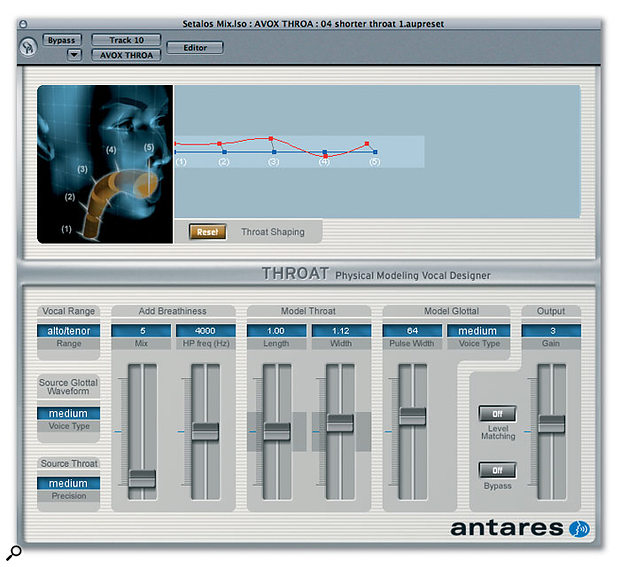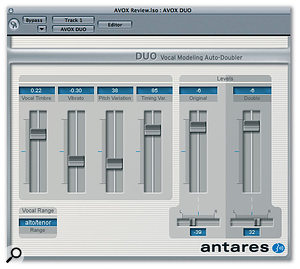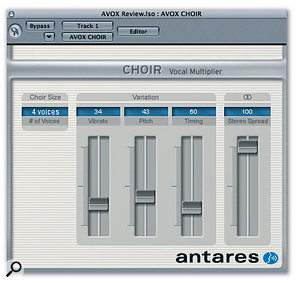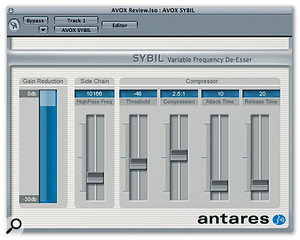 Throat is designed to change vocal character by processing a real vocal track through a virtual vocal tract, with controls to change the throat shape and size, breathiness and glottal waveform.
Throat is designed to change vocal character by processing a real vocal track through a virtual vocal tract, with controls to change the throat shape and size, breathiness and glottal waveform.
With their new plug-in suite, Antares promise to let you change the character of the human voice.
Antares have been a major player in vocal processing ever since they unleashed Auto-Tune upon an unsuspecting world, so anything new that they come out with is always worth a closer look. A recurring dream of engineers and producers is to be able to adjust the character of the human voice in a more or less natural way to make one singer sound more like another, and it's probably true to say that until this particular suite of Antares plug-ins appeared, TC-Helicon were the only big name doing anything significant in that particular market sector. Now Antares have joined the race, and though we're still a long way from the 'Dial E for Elvis' box, a lot of interesting vocal manipulation is now possible.
Supplied in VST and RTAS versions on Mac and PC, and Audio Units on Mac OS, Avox is protected using iLok; an iLok key is included in the package so you don't have to go out and buy one. Installation is straightforward, and you can run the program for 10 days prior to authorisation if for some reason you're not able to access the Internet to authorise your iLok key immediately.
Deep Throat
Avox is actually a suite of vocal effects, and appears as five separate plug-ins named Choir, Duo, Punch, Sybil and Throat. Since the latter is the most ambitious of the plug-ins, I'll begin with it. Throat is designed to change vocal character by processing a real vocal track through a virtual vocal tract, with controls to change the throat shape and size, breathiness and glottal waveform.
Avox 's modelled throat is divided into four sections, which can be changed in length and width to subtly or otherwise change the character of the sound being processed. A graphical display allows five points on the virtual throat to be dragged horizontally and vertically, with the original positions also being shown for comparison purposes. For Throat to do a good job, you need to tell it some basic facts about the source voice (or other sound) using a menu that lets you choose from soprano, alto/tenor, bass/baritone and instrument. The glottal waveform is the basic sound produced by the vocal cords prior to filtering by the vocal tract, and varies quite a lot between different singers. Here we have a menu of options that goes from hard to soft plus a pulse-width fader, and while this might be simplistic by comparison with a real voice, it still provides plenty of leeway for tonal variation. When a voice type is loaded, an appropriate glottal waveform is selected by default. Maybe version 2 will come with drag-and-drop vocal cord nodules for those Rod Stewart impressions?
Next comes a control menu called Source Throat Precision, which relates to how accurately the algorithm tries to model the throat you've set up. As a rule, high precision settings work best for subtle vocal adjustments while lower precision settings can produce smoother results when creating more radical effects, and can also reduce whistling artifacts caused by extreme settings. The manual suggests that you always start with this parameter set to 'subtle' and then work up the list a step at a time until you find the best-sounding option.
Breathiness Mix adds a synthesized breathiness to the sound, the character of which is drawn from the source sound and modified using the adjacent frequency slider. This needs to be used quite subtly to maintain a natural sound, and if you need a Darth-Vader-with-asthma effect, there's more than enough range to achieve that.
Once the faders are set and the menu options selected, you can start having fun in the Graphic Throat display by dragging the five boundary points in any direction; the grey band in the centre shows roughly where natural adjustments cease and creative abuse starts. The original throat plot is shown in blue, while the points you drag to new positions show up in red. The Length fader then scales these settings up or down globally. Should you stumble on some interesting dynamic effects while editing, you can automate the point positions in your sequencer to create, for example, the sound of somebody singing while being strangled! When audio is being processed, the display also shows the original and remodelled throat contours in real time, again in blue and red. A reset button puts the vocal tract back to its default start points, output gain provides up to 24dB of gain to compensate for level changes caused by the modelling process and Level Matching, when active, tries to make an automatic level compensation so the output is of similar loudness to the input. It is recommended that Level Matching be used only for comparison purposes and that it be switched off for serious use as it compromises the audio quality very slightly.
Throat is a mono plug-in and requires a clean, monophonic source to work effectively as it needs to track the pitch of the incoming voice. A range of presets has been provided, but as every voice is different, these should be regarded as starting points only. My tests produced results that had an obvious parallel with the TC Voice Modeller plug-in for Powercore, insomuch as you have to keep the adjustments fairly small if you want to keep the sound natural. Go too far and you start to sound like a blackmailer's phone call or one of Doctor Who 's enemies! More than a little processing also tends to lend the vocal sound a slightly lo-fi quality, and while it can be interesting to really push the sound into this realm for darker hip-hop vocal sounds, it is to be avoided for conventional vocal work. My own view is that used carefully, Throat can be used to create some really useful variations, but I don't think I'd often use it on a main vocal part unless I was after something obviously treated.

 Choir takes the Duo concept one step further by allowing the user to add four, eight, 16 or 32 voices, all based on processes applied to one original part.
Choir takes the Duo concept one step further by allowing the user to add four, eight, 16 or 32 voices, all based on processes applied to one original part.
Hearing Double
The Duo 'auto doubler' is an altogether simpler prospect, and sets out to emulate traditional double-tracking by processing a copy of the original vocal to change its timing, pitch and amount of vibrato. Again, it needs to be told the approximate vocal range of the input in order to be able to track the pitch effectively, so you have to pick from soprano, alto/tenor, bass/baritone or instrument. After that you simply have four sliders for controlling Timbre, Vibrato, Pitch and Timing, all of which introduce variations on the characteristics of the original voice. It should be noted that Vibrato acts on any vibrato present in the original voice, so if none is present, there will be no effect. Two further level sliders and pan pots allow the original and processed voices to be positioned in the mix. With timing set to maximum, you get a distinct slapback sound, whereas at lower settings the result is more akin to two singers trying to perform the same part. A degree of randomisation has been introduced to stop the process sounding to mechanically perfect.
While I'm not convinced that Duo reproduces the same life and sparkle as a really good natural double-tracking job, the overall effect is still pretty realistic and the ability to tweak the character of the doubling voice slightly just adds to the illusion. The best results are achieved by panning the two voices to either side of centre and by not going overboard with the variation controls. While the plug-in can work in stereo mode, it processes only the left channel, so it is best to use it in mono-in, stereo-out mode.
Bring The Noise
Choir takes the Duo concept one step further by allowing the user to add four, eight, 16 or 32 voices, all based on processes applied to one original part. The controls are similar to those of Duo but without the Timbre parameter: there are sliders for Vibrato, Pitch and Timing variation, with a further slider setting the stereo spread. The result is slightly artificial if scrutinised in isolation, but it gets far more realistic when you add concert hall reverb. For me the smaller four- and eight-voice choir sizes sounded the most realistic, so building up a large choir from several instances of the plug-in working on three or four original vocal parts would be a better option than trying to emulate a whole choir part based on one vocal track — and of course you'd have to do this anyway to build up harmony parts. Again only the left channel is processed if you use the plug-in in stereo mode, and the more voices you specify, the greater the CPU load.
By combining compression and limiting in a single plug-in with a very simple control interface, Punch provides a simple way to get a vocal part to sit in the track. The Gain control adjusts the level of the signal feeding into the plug-in, while Impact sets the degree of compression/limiting applied to the signal. Ceiling sets the maximum level that the signal is allowed to reach, so in use, the controls are more like those of a limiter than a compressor. The effect of the processing can be seen in the dynamics of the output level meter but there's no dedicated gain-reduction meter, and I didn't feel comfortable without one. Though you should use your ears, I also like to be able to see how much the signal is being hammered!
 Punch has both mono and stereo versions and is certainly successful in creating that solid, up-front vocal sound without having to juggle a host of parameters.
Punch has both mono and stereo versions and is certainly successful in creating that solid, up-front vocal sound without having to juggle a host of parameters. Sybil is really a digital emulation of an old-school de-esser.Punch has both mono and stereo versions and is certainly successful in creating that solid, up-front vocal sound without having to juggle a host of parameters, though if you apply too much Impact, breathing artifacts start to show up as they do with any over-enthusiastic application of compression. With the addition of a gain-reduction meter, this plug-in would have really won me over, but even without, you can nail the level of a vocal track in a mix without being a compression wizard.
Sybil is really a digital emulation of an old-school de-esser.Punch has both mono and stereo versions and is certainly successful in creating that solid, up-front vocal sound without having to juggle a host of parameters, though if you apply too much Impact, breathing artifacts start to show up as they do with any over-enthusiastic application of compression. With the addition of a gain-reduction meter, this plug-in would have really won me over, but even without, you can nail the level of a vocal track in a mix without being a compression wizard.
Sybil Engineering
While most of the plug-ins in Avox include some clever twists on what has gone before, Sybil is really a digital emulation of an old-school de-esser, where a high-pass-filtered side-chain forces a compressor to pull down the overall signal level when 'S' and 'T' sounds are detected. A gain-reduction meter shows how much the level is being attenuated when processing is taking place, while a variable high-pass filter (which defaults to an 8kHz cutoff) lets you home in on the frequency above which sibilance occurs. Threshold sets the level at which detected sibilance triggers gain reduction while the compressor section has its own attack, release and ratio controls.
Sybil is mono-only, and because it works like an old-school de-esser, it pulls down the level of everything when sibilance is detected, not just the high-frequency sibilant sounds. Used moderately it works fine and is easy to set up, thanks in part to the gain-reduction meter, but if you overdo it, the processed sound takes on a lisping quality, which isn't particularly attractive. In this respect, Sybil isn't so much faulty as unsophisticated! I would imagine that most DAWs include a de-esser plug-in that's at least as effective as this one, so I can't quite see why Antares didn't go the extra mile and have the compressor act only on the upper half of the frequency spectrum or, better still, just on the frequency band containing the sibilance.
Impressions
On the whole, Antares have come up with a suite of creative and easy-to-use plug-ins that make vocal manipulation very straightforward. My least favourite is the rather conventional (but still very functional) de-esser, as I think there are numerous better options available, but everything else does what it is claimed to do with an added dash of panache. Choir, when used to turn three or four singers into a choir, is most impressive, especially once you add a nice church or concert hall reverb, while Duo does a good job of turning one vocal into a plausible double-tracked part. It's still not as good as real double-tracking done well, but then not every vocalist can sing an accurate double-tracked part. These effects also work well on monophonic instruments.
Punch doesn't do anything you can't achieve by other means but its simple interface should win it a lot of friends, as other than setting levels, you only have an amount slider to deal with and it does exactly what's required to pump up the vocal sound and to stabilise its level. If you can't get your vocal to sit in a track using this, it's probably deficient in some other way. It's a shame that more of the entry-level compression plug-ins don't follow this example as there's still a lot of confusion about how best to use a compressor.
Throat is the most complex of the plug-ins and also the one likely to cause the most controversy over whether it sounds any good or not. Used with caution, it can add that missing edge or depth to voice without sounding unduly processed, and those into rap or hip-hop will probably appreciate some of its more aggressive settings. However, Antares have deliberately allowed this plug-in to go way beyond anything that might occur in nature, so sound designers for film may also find it useful. Some of the sounds you can get out of it are truly bizarre, yet you can still hear every word! If you need the sound of a snake with dentures or a cave troll singing while having a tracheotomy, this is your guy. For all that, Throat is still pretty easy and quick to use, as is the rest of this flexible and creative bundle.
Pros
- Easy to use.
- Flexible and creative vocal processing tools.
- Can create abstract as well as realistic vocal sounds.
Cons
- Throat has to be used carefully in order to retain a natural vocal sound.
Summary
As a bundle, Avox offers the promise of creativity without tears and on the whole it lives up to that promise. Vocal modelling and resculpting still has a long way to go, but there are some genuinely useful tools here that are surprisingly straightforward in use.
information
£399.50 including VAT.
Unity Audio +44 (0)1440 785843.
+44 (0)1440 785845.
